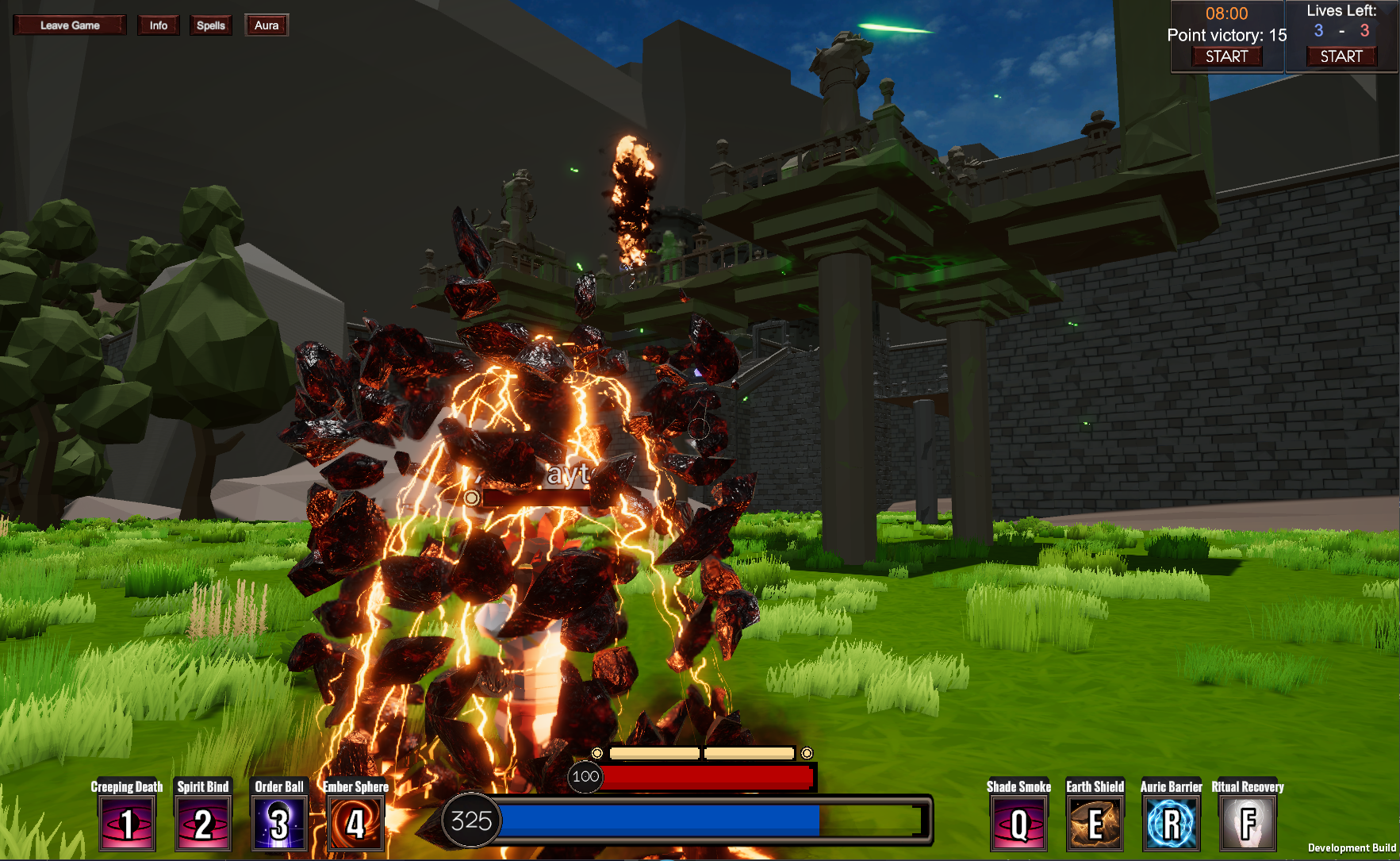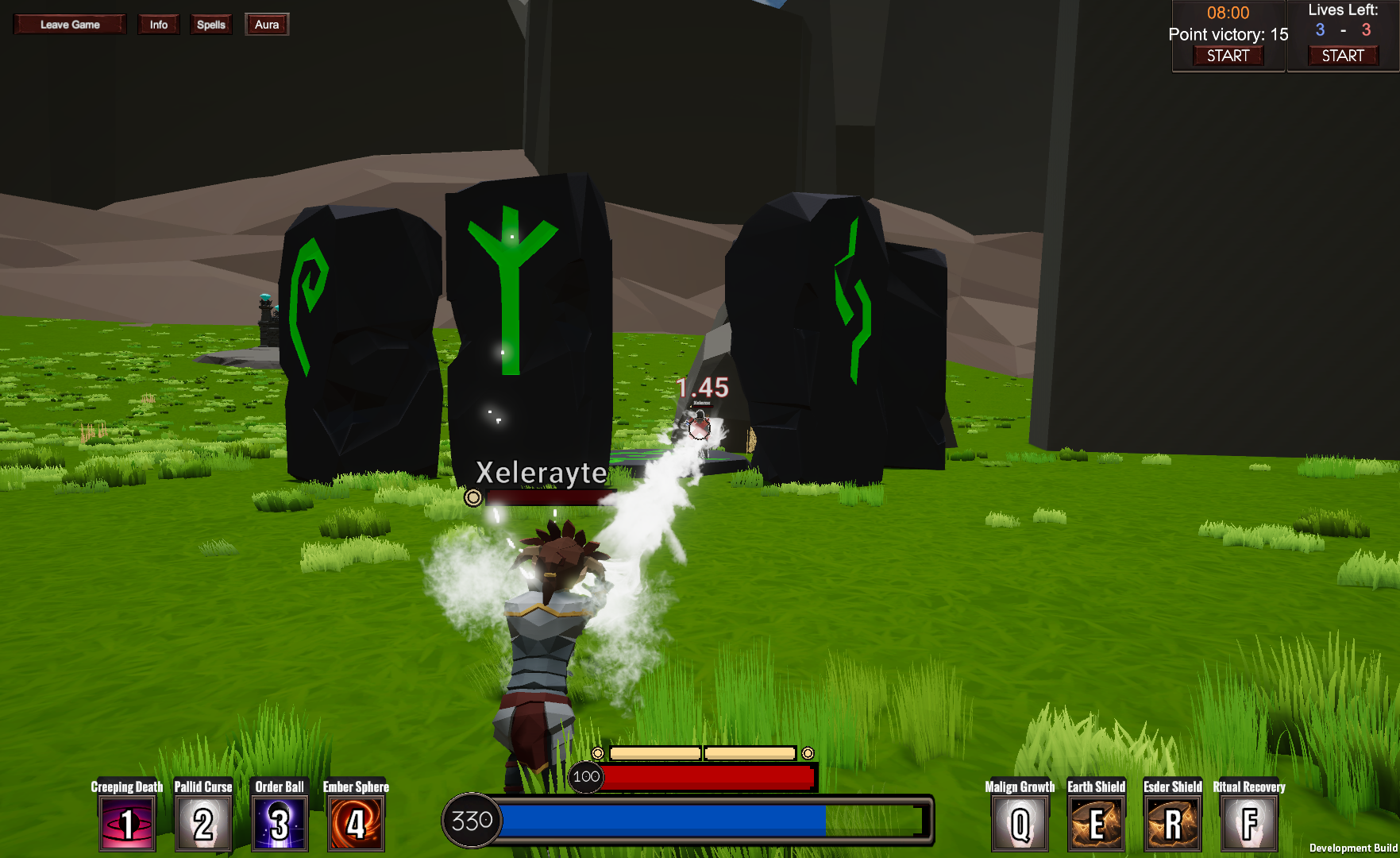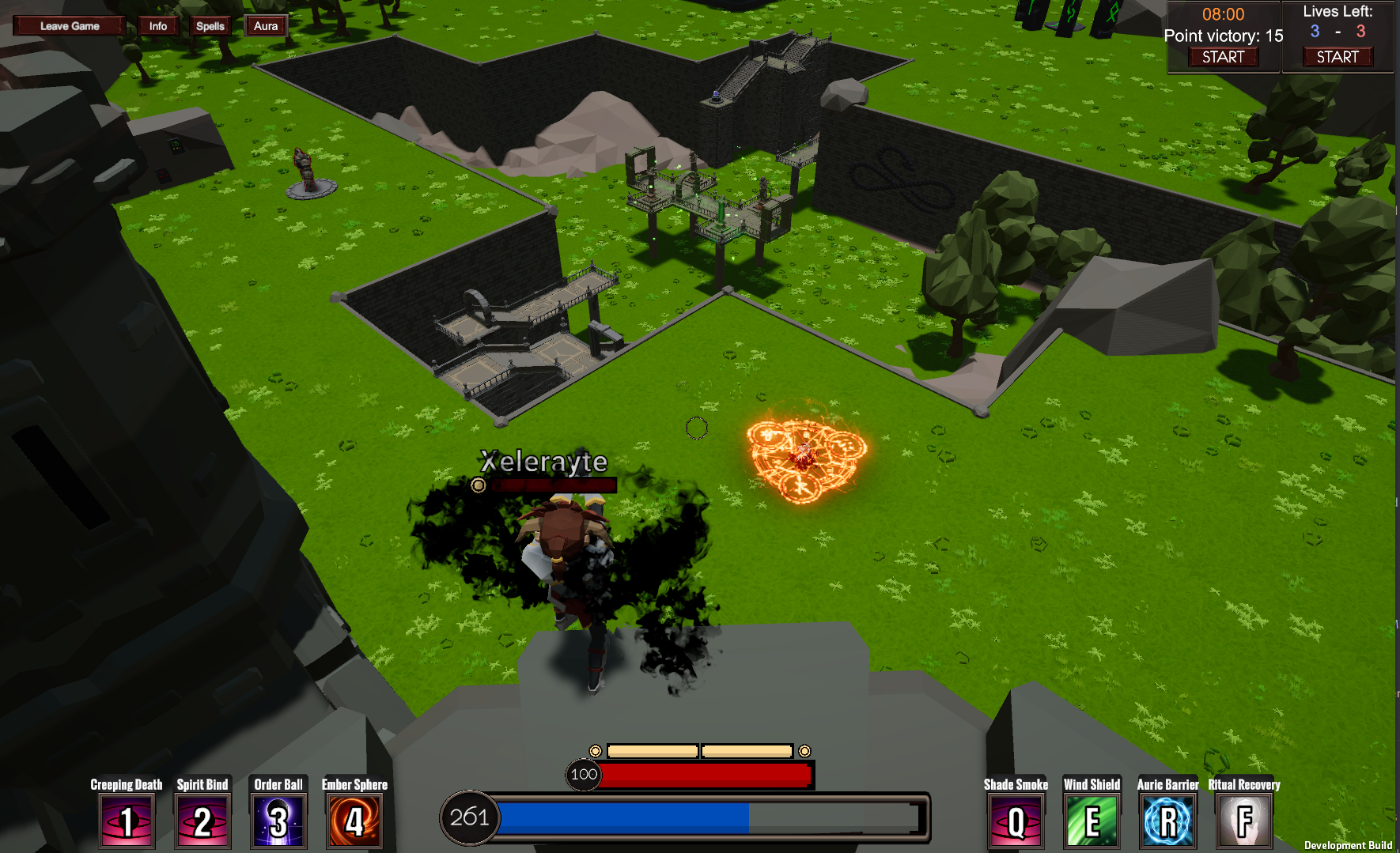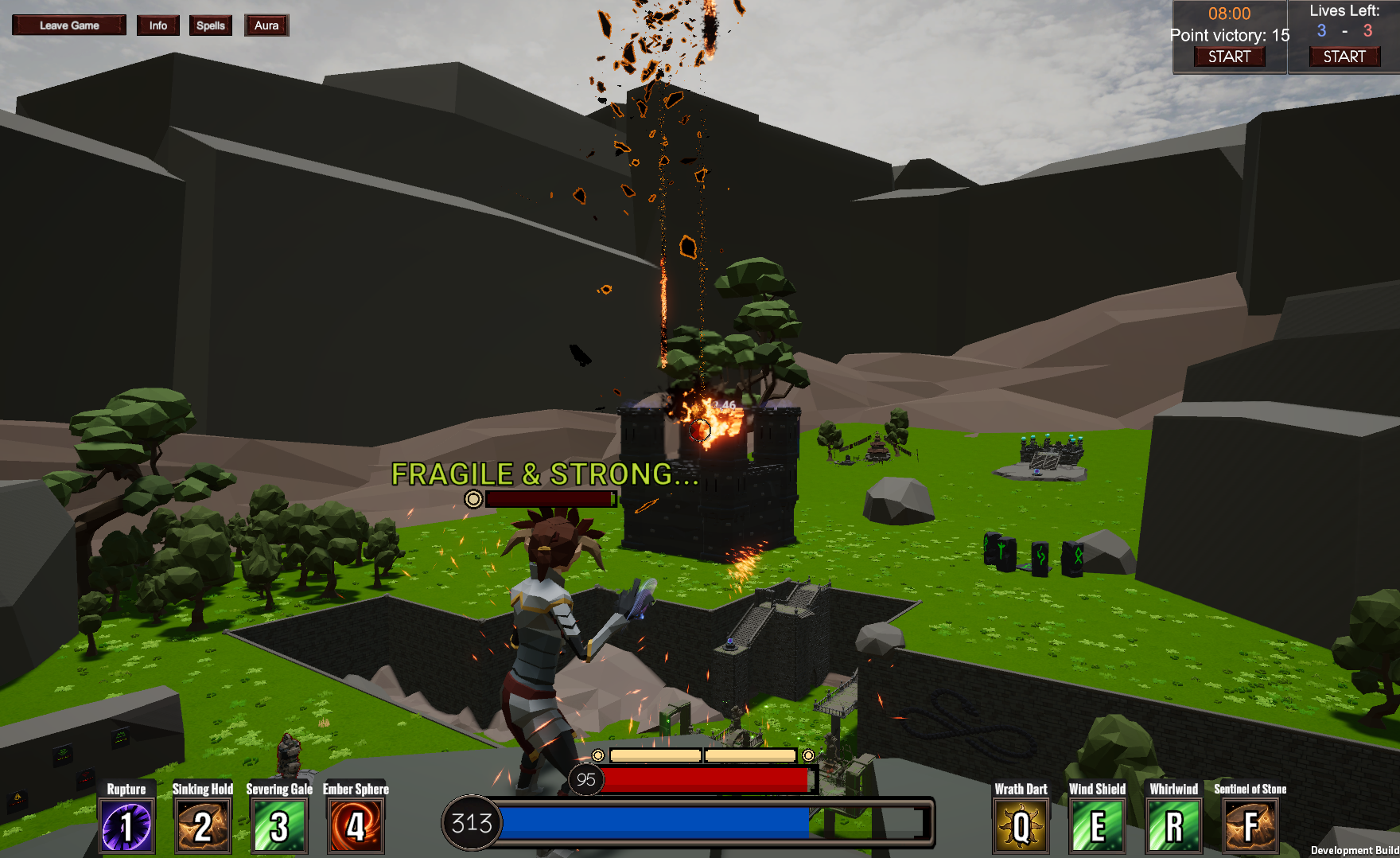Aurica
Description
Wield powerful and diverse magic in a strategic battle between mages. Every player is unique, with a pseudo-randomly generated Aura that interacts with every spell you cast and every hit you take. Aurica has a magic system with unparalleled depth and intricacy. The ceiling for growth in Aurica is limited only by your dedication.
Players face each other in multiplayer battles of skilled spell casting. To excel, players must learn the strengths of their own pseudo-randomly generated Aura. A player’s Aura is a distribution of mana that will interact with spell casting to make spells stronger or weaker depending on how the spell is composed. The magic system is incredibly deep but retains an ease-of-use that lets casual players have as much fun as the more dedicated players.
There are a wealth of spell options to choose from in each battle, with over 110+ unique spells from 10 different schools of magic, and more are being developed constantly.
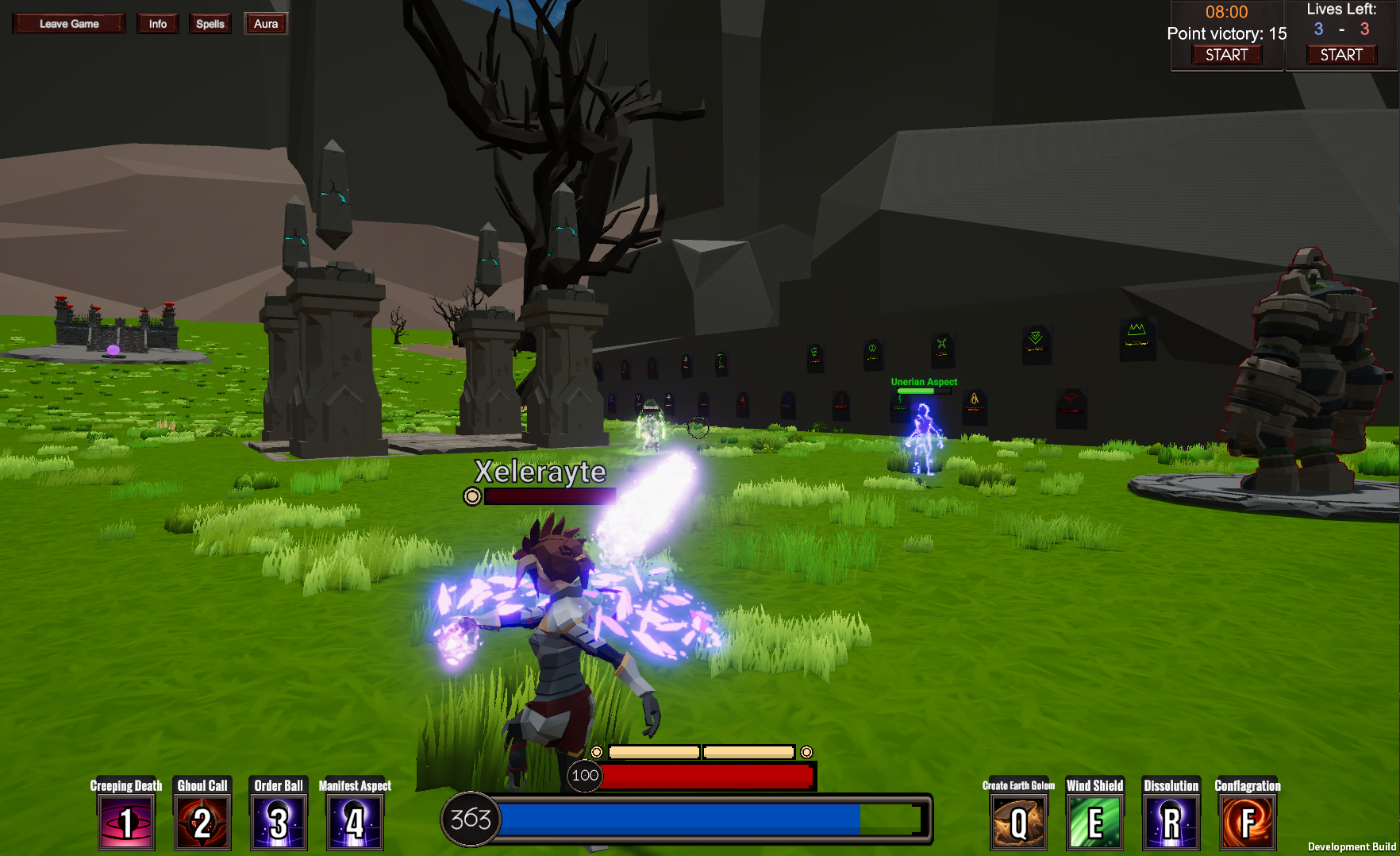
Novel features
The intent of the magic system is to create a novel system for spell-casting that has incredible depth but maintains a low barrier of entry for casual players. Some key features of the system include:
- Unique player Auras: every player has a completely unique Aura that influences how the magic system works for them.
- Personality-based strengths: take the quiz or randomly roll your Aura to shape the magic system to your preferences.
- Classless spell-casting: every player can cast any spell at any time.
- Glyph drawing: spell components can be drawn on the screen with glyphs to cast spells and rebind your loadout on the fly!
- Spell crafting: spells can be crafted using components to have enhanced effects at the cost of additional mana.
- 10 mana types: many different mana types each with their own lore, unique spell-styles and type identities!
- Cultivation: participating in PvP matches or defeating tough enemies in adventure mode earns cultivation to develop your Aura.
See it on GitHub
The GitHub page is usually the most up-to-date source of content for this project.
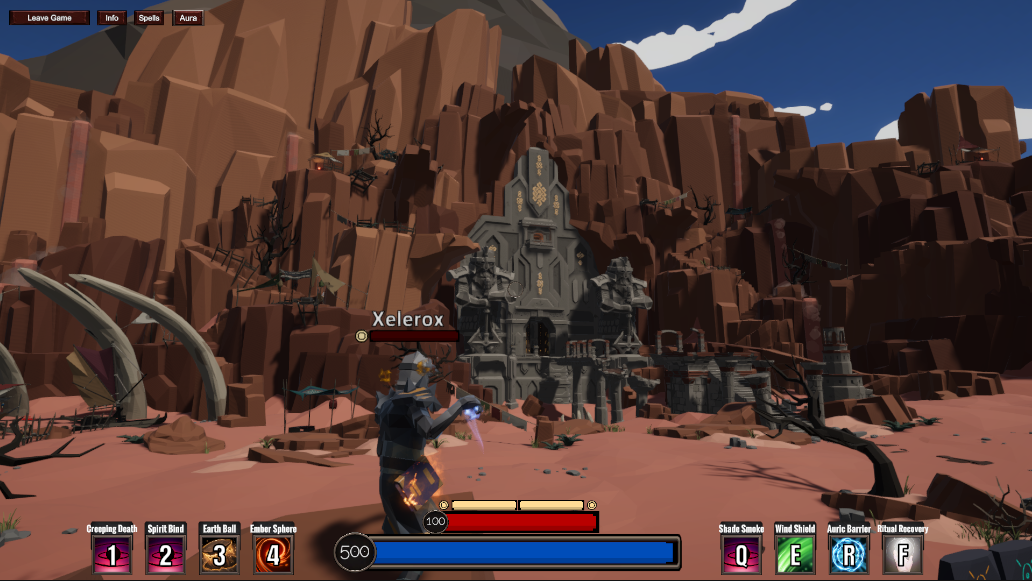
Gameplay and Design
Core gameplay loops
The core gameplay loops for when players get into a lobby are similar to most match-based PvP or PvE games. In the downtime before and between the fights the player can choose to rebind their spell loadout to better suit the coming match. Environmental advantages, or knowing the opponent’s favoured spells, can completely change the optimal strategy.
New players can skip these difficult decisions by choosing a class loadout from pedestals that give a static set of spells. The classes range from playstyle-based (ex. a short-range aggro mage, area-control AoE mage, summoner style, etc…) to mana types (ex. all fire spells, all death spells, etc…). These class loadout stones are hidden throughout the game world, as playtests where all classes were immediately available from the start proved overwhelming for the players.
Pictured below are two class loadouts, for the Infernomancer (fire mage) and Warlock (demonic mage) respectively.


Player versus Player (PvP) loop
- Enter a PvP arena room using a room code or going to the default room
- Experiment with magic and find the right spell loadout
- Advanced: Go through spell crafting gameplay loop (see below)
- Start the match
- Cast spells for defense and spells to attack your opponent(s)
- Advanced: Rebind spell loadout on the fly to counter opponents spells
- Win/Lose
- Repeat from step 2
Player versus Environment (PvE) loop
- Enter adventure mode
- Experiment with magic and find the right spell loadout
- Advanced: Go through spell crafting gameplay loop (see below)
- Explore the area in search for enemies or static loot
- Find an enemy or group of enemies
- Advanced: Rebind spell loadout to best deal with the enemies resistances and attacks
- Defeat the enemy
- Gather cultivation point loot crystals
- If satisfied with your current spell loadout, repeat from step 3. Otherwise, repeat from step 2
Spell crafting loop
- Choose a spell to begin crafting
- Cast the key components for that spell
- Advanced: if the key components have a flux or siphon distribution they can be cast later for full effect or first to have no effect
- Observe the ideal mana distribution for the chosen spell, as well as the spell strength and mana cost of the current casting
- Determine which mana types are far from the ideal levels
- Find a spell component that will bring the mana in the current casting towards the ideal mana for the spell
- Cast that component into the spell and observe the new spell strength percentage and increased mana cost
- If the spell strength is not at an acceptable level (150% is the maximum strength) AND the mana cost of the crafted spell is within a reasonable amount, repeat from step 3
- Bind the newly crafted spell to your current loadout by clicking one of the bound spell buttons along the bottom of the screen
Motivations for unfairness
Offering an individualized experience
Because of the unique Auras, every player is going to have a different experience with the magic system and will go through a different learning and growth process. I plan to implement as many mechanics as is reasonable to encourage this aspect of the magic system.
The primary gate to progression is knowledge. There are very few limitations on which spells you can cast. Theoretically you can go from a naïve player to a dominating archmage in just one day (which I think is a very compelling fantasy). However, there has to be a way to slow players down from reaching maximum power by just reading a few wiki articles. The individualized Aura is my attempt at solving some of this problem. Players can’t copy spells from each other because the spells could have drastically different efficiencies if their Auras are even minorly different. To progress you must go experiment with spells and combos, then craft your favorite spells into stronger versions with the spell crafting system. Later on, as the player cultivates their Aura into their desired shape, sharing spells and metagaming can arise.
There is much more planned for creating an individualized experience. If it seems like what there is right now isn’t enough for this to get your interested I implore you to wait and see.
Thematic comparison with nature
Let’s start off this section with a nice and big hypothetical question, if magic were to exist in the real world as we know it, how would it work? In my imagined world, magic would behave very similarly to nature. The physical world as we know it has occurred entirely through random chance, but follows the same fundamental laws, physics. If magic were to exist on earth I would picture it to work similarly. Completely unbound by everything but the laws of magic itself.
The way living things experience the randomness of nature is largely unfair. Survival is for the fittest and evolution picks the winners. There is nothing fair about a fight between a rested lion and a tired antelope. There is nothing fair about a race from a tsunami between a genetically gifted runner and someone born with cerebral palsy. Genetics and different environments are massively unfair circumstances that we deal with daily. Genetics is the basis for the idea of magic users to have unique Auras. Like genetics, it is started with a base of a random roll and with influence from your personality and actions it will grow towards your ideals. At the beginning it might be very unfair, but if you train enough you can make a strong comeback from a hard start.
Challenges
I will freely admit that this kind of gaming experience is not for everyone. The magic system isn’t the best for mass-market consumers who want quick, easy, and viscerally satisfying advancement. Instead, it is designed for dedicated players who care enough to better their skills within the deep and rich magic system.
However, the game that this magic system resides in does not have to follow that exact same standard. Efforts can and are made to make the game as engaging as possible for casual players. Any player should be able to hop into the game and start blasting away with spells. The spells they throw may not be very high powered or at all suited to their Aura but with smart enough design and game feel the experience can still provide that quick and high impact fun that casual gamers can enjoy.
Game Balance
Balance in an innately unfair system like this is obviously incredibly difficult. There has to be a competitively viable strategy for every player, regardless of their random Aura. One way I am trying to approach this issue is by having a large variety of spells compared to other games of this genre. Not every spell will require high levels of Aura, there are plenty of spells that work better when your Aura levels are comparatively low. For every Aura combination there will be spells that you can cast at high efficacy. The secondary effects of spells also scale with spell strength so even if a relatively low-power-budgeted spell is cast at a very high efficacy it can have the same, or better, effects as a more powerful spell cast at low efficacy.
One problem with this tactic is that casual players might have an issue with their perceived game balance. Inexperienced players will most likely look at a powerful player and complain about not being able to cast any of the same spells. I haven’t found the right solution to this yet but my initial thoughts are to provide players with a tutorial that guides them through their strengths and recommends spells that would be best for their Aura.
This article is a work in progress. I will update this post as I learn more and make further discoveries about the game systems.
Check out the Wiki for a deep-dive on how the spell casting mechanics work!
Adventure Mode Screenshots
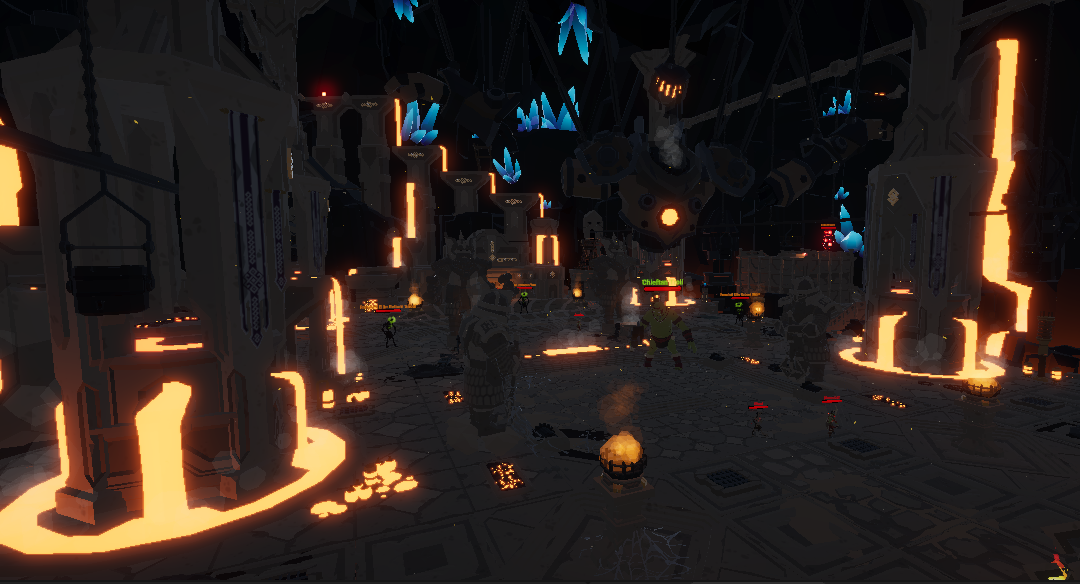
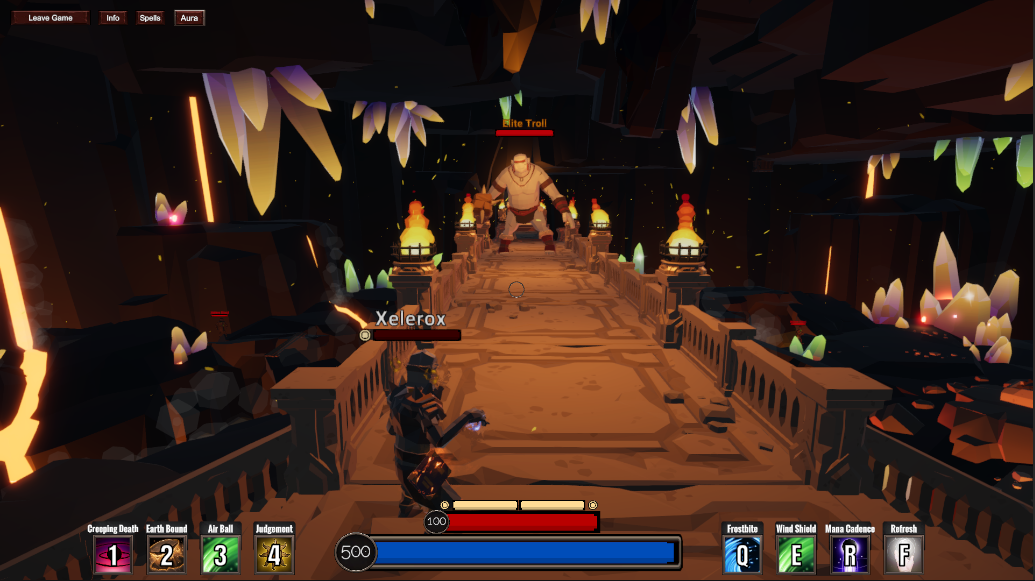
PvP Arena Screenshots

